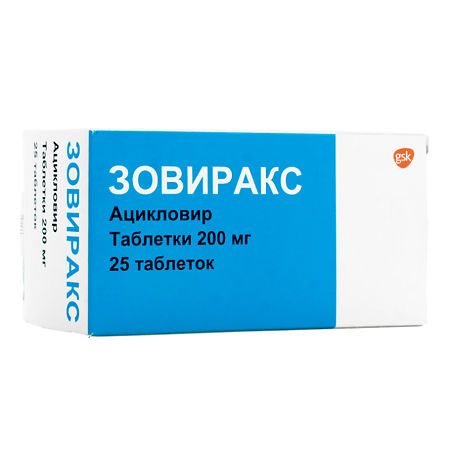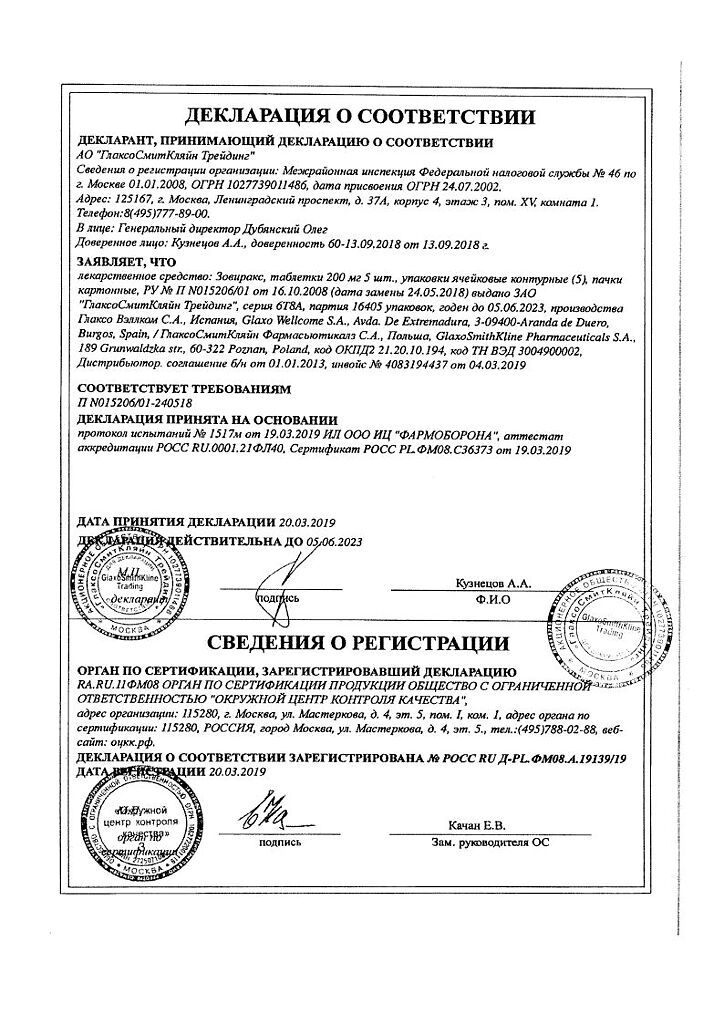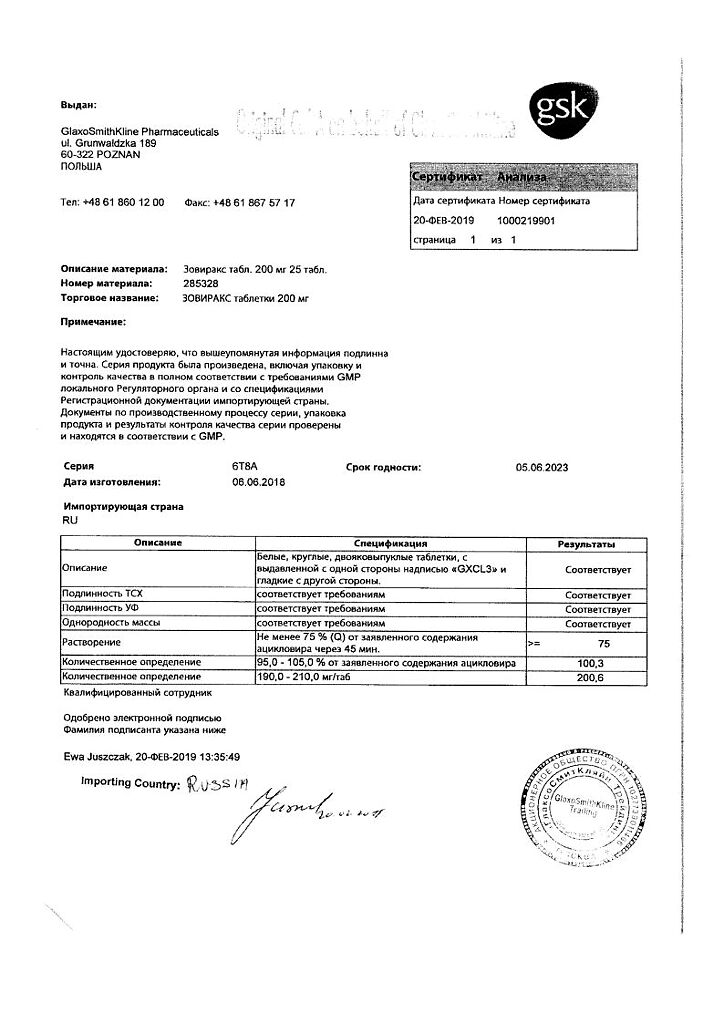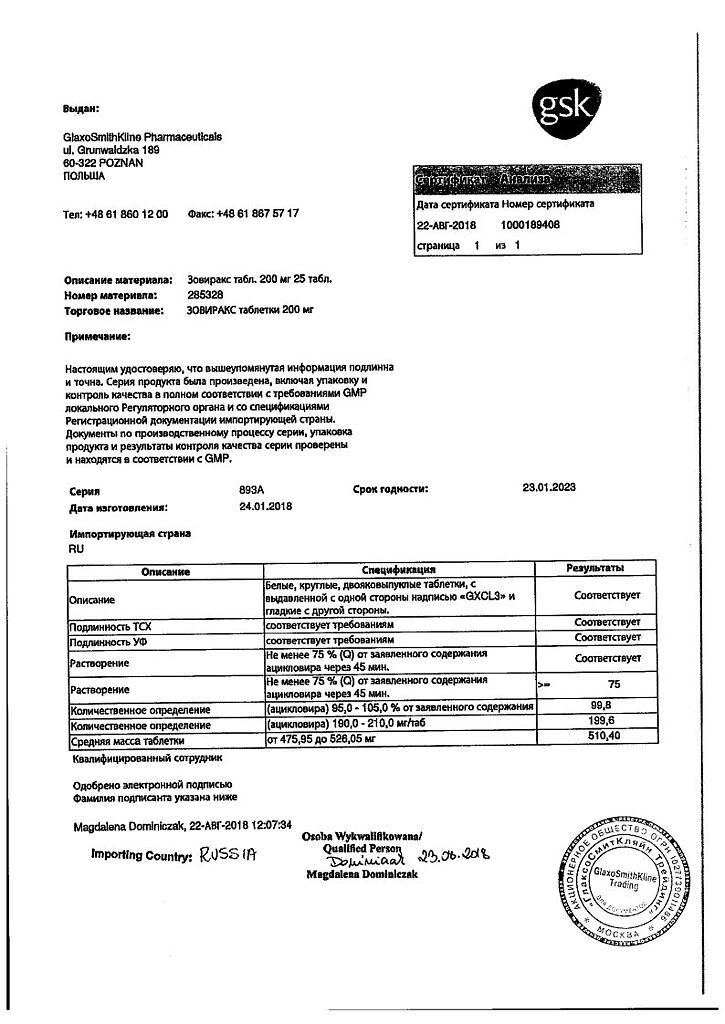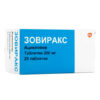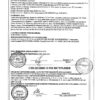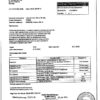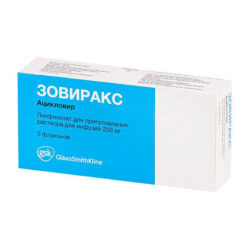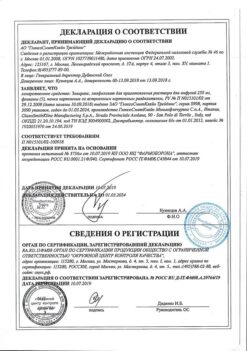No products in the cart.
Description
Pharmacological group: antiviral.
ATX code: [J05AB01].
PHARMACOLOGICAL PROPERTIES
Pharmacodynamics
Mechanism of action
Acyclovir is a synthetic analog of the purine nucleoside, which has the ability to inhibit in vitro and in vivo replication of human herpes viruses, including herpes simplex virus (HSV) types 1 and 2, varicella and shingles virus (VZV), Epstein-Barr virus (EBV) and cytomegalovirus (CMV). In cell culture acyclovir exhibits the most expressed antiviral activity against HSV-1, followed by HSV-2, VZV, EBV and CMV in descending order of activity.
The activity of acyclovir against herpes viruses (HSV-1, HSV-2, VZV, EBV, CMV) is highly selective. Acyclovir is not a substrate for thymidine kinase enzyme of uninfected cells, so acyclovir is little toxic to mammalian cells. Thymidine kinase of cells infected with HSV, VZV, EBV and CMV transforms acyclovir into acyclovir monophosphate, a nucleoside analog, which is then sequentially transformed into diphosphate and triphosphate by cellular enzymes. Incorporation of acyclovir triphosphate into the viral DNA chain and subsequent chain breakage blocks further replication of viral DNA.
In patients with severe immunodeficiency long-term or repeated courses of acyclovir therapy can lead to the formation of resistant strains, and therefore further treatment with acyclovir may be ineffective. Most acyclovir-resistant strains isolated have relatively low levels of viral thymidine kinase, impaired viral thymidine kinase structure or DNA polymerase). Exposure of HSV strains to acyclovir in vitro may also result in the formation of less sensitive strains. There is no correlation between the sensitivity of HSV strains to acyclovir in vitro and the clinical efficacy of the drug.
Pharmacokinetics
Acyclovir is only partially absorbed from the intestine. After administration of 200 mg of acyclovir every 4 hours, the mean maximum equilibrium plasma concentration (Cssmax) was 3.1 µmol (0.7 µg/mL) and the mean equilibrium minimum plasma concentration (Cssmin) was 1.8 µmol (0.4 µg/mL). When 400 mg and 800 mg of acyclovir were taken every 4 hours, Cssmax was 5.3 µmol (1.2 µg/mL) and 8 µmol (1.8 µg/mL), respectively, and Cssmin was 2.7 µmol (0.6 µg/mL) and 4 µmol (0.9 µg/mL), respectively.
Acyclovir half-life is 2.5-3.3 hours. Most of the drug is excreted unchanged by the kidneys. Renal clearance of acyclovir is much higher than creatinine clearance, which indicates excretion of acyclovir not only by glomerular filtration, but also by tubular secretion. The main metabolite of acyclovir is 9-carboxymethoxy-methylguanine, which accounts for about 10-15% of the administered dose of the drug in the urine. When administering acyclovir 1 hour after taking 1 g of probenecid the half-life of acyclovir and the area under the curve “concentration in plasma – time” increased by 18 and 40% respectively.
In elderly patients acyclovir clearance decreases with age in parallel with a decrease in creatinine clearance, but the half-life of acyclovir changes slightly.
In patients with chronic renal failure the half-life of acyclovir averaged 19.5 hours. During hemodialysis the average half-life of acyclovir was 5.7 h, and the plasma concentration of acyclovir decreased by approximately 60%.
The concentration of acyclovir in the cerebrospinal fluid is approximately 50% of its plasma concentration. Acyclovir binds insignificantly to plasma proteins (9-33%), therefore drug interactions through protein binding mechanism are unlikely.
When concomitant administration of acyclovir and zidovudine to HIV-infected patients pharmacokinetic characteristics of both drugs were virtually unchanged.
Indications
Indications
Treatment of skin and mucous membrane infections caused by the herpes simplex virus, including primary and recurrent genital herpes;
Prevention of recurrence of infections caused by the herpes simplex virus in patients with normal immune status;
Prevention of infections caused by the herpes simplex virus in patients with immunodeficiency;
Treatment of chickenpox and herpes zoster;
Treatment of patients with severe immunodeficiency, mainly with advanced stages of HIV infection (CD4+ cell count less than 200/mm in patients with AIDS or severe manifestations of the AIDS-associated complex) and patients who have undergone bone marrow transplantation. Studies have shown that combination therapy with Zovirax and antiretroviral drugs (mainly oral zidovudine) significantly reduces mortality in patients with advanced AIDS and patients who have undergone bone marrow transplantation.
Pharmacological effect
Pharmacological effect
Pharmacological group: antiviral agent.
ATX code: [J05AB01].
PHARMACOLOGICAL PROPERTIES
Pharmacodynamics
Mechanism of action
Acyclovir is a synthetic purine nucleoside analogue that has the ability to inhibit in vitro and in vivo replication of human herpes viruses, including herpes simplex virus (HSV) types 1 and 2, varicella zoster virus (VZV), Epstein-Barr virus (EBV) and cytomegalovirus (CMV). In cell culture, acyclovir has the most pronounced antiviral activity against HSV-1, followed in descending order of activity by: HSV-2, VZV, EBV and CMV.
The effect of acyclovir on herpes viruses (HSV-1, HSV-2, VZV, EBV, CMV) is highly selective. Acyclovir is not a substrate for the thymidine kinase enzyme in uninfected cells, so acyclovir is slightly toxic to mammalian cells. Thymidine kinase in cells infected with HSV, VZV, EBV and CMV viruses converts acyclovir to acyclovir monophosphate, a nucleoside analogue, which is then sequentially converted to diphosphate and triphosphate by cellular enzymes. The inclusion of acyclovir triphosphate in the viral DNA chain and subsequent chain termination blocks further replication of the viral DNA.
In patients with severe immunodeficiency, long-term or repeated courses of acyclovir therapy may lead to the formation of resistant strains, and therefore further treatment with acyclovir may be ineffective. The majority of isolated strains with reduced sensitivity to acyclovir had a relatively low content of viral thymidine kinase and a disturbance in the structure of viral thymidine kinase or DNA polymerases. Exposure of HSV strains to acyclovir in vitro may also result in the formation of strains that are less sensitive to it. A correlation has not been established between the sensitivity of HSV strains to acyclovir in vitro and the clinical effectiveness of the drug.
Pharmacokinetics
Acyclovir is only partially absorbed from the intestine. After administration of 200 mg of acyclovir every 4 hours, the mean maximum steady-state plasma concentration (Cssmax) was 3.1 μmol (0.7 μg/ml) and the mean steady-state minimum plasma concentration (Cssmin) was 1.8 μmol (0.4 μg/ml). When taking 400 mg and 800 mg of acyclovir every 4 hours, Cssmax was 5.3 µmol (1.2 µg/ml) and 8 µmol (1.8 µg/ml), respectively, and Cssmin was 2.7 µmol (0.6 µg/ml) and 4 µmol (0.9 µg/ml), respectively.
The half-life of acyclovir is 2.5-3.3 hours. Most of the drug is excreted unchanged by the kidneys. The renal clearance of acyclovir significantly exceeds the clearance of creatinine, which indicates that acyclovir is eliminated not only through glomerular filtration, but also by tubular secretion. The main metabolite of acyclovir is 9-carboxymethoxy-methylguanine, which accounts for about 10-15% of the administered dose of the drug in the urine. When acyclovir was administered 1 hour after taking 1 g of probenecid, the half-life of acyclovir and the area under the plasma concentration-time curve increased by 18 and 40%, respectively.
In elderly people, the clearance of acyclovir decreases with age in parallel with a decrease in creatinine clearance, however, the half-life of acyclovir changes slightly.
In patients with chronic renal failure, the half-life of acyclovir averaged 19.5 hours. During hemodialysis, the average half-life of acyclovir was 5.7 hours, and the plasma concentration of acyclovir was reduced by approximately 60%.
The concentration of acyclovir in the cerebrospinal fluid is approximately 50% of its plasma concentration. Acyclovir binds to plasma proteins to a small extent (9-33%), so drug interactions through protein binding are unlikely.
When acyclovir and zidovudine were administered simultaneously to HIV-infected patients, the pharmacokinetic characteristics of both drugs remained virtually unchanged.
Special instructions
Special instructions
Hydration status: Patients taking high doses of Zovirax by mouth should receive adequate fluid intake. Elderly patients and patients with renal insufficiency: Patients in this group are at increased risk of developing side effects from the nervous system (such reactions are usually reversible in response to drug withdrawal), and therefore should be under close medical supervision.
Transmission of infection: It is necessary to inform patients about the possibility of transmission of the genital herpes virus during the period of rash, as well as about cases of asymptomatic carriers of the virus.
INFLUENCE ON THE ABILITY TO DRIVE
No data.
Active ingredient
Active ingredient
Acyclovir
Composition
Composition
Active substance:
acyclovir 200.0 mg;
Other components:
lactose monohydrate,
microcrystalline cellulose,
sodium carboxymethyl starch,
povidone K30,
magnesium stearate.
Pregnancy
Pregnancy
Pregnancy
An analysis of women treated with acyclovir during pregnancy did not reveal an increase. the number of birth defects in their children compared to the general population. However, caution should be exercised when prescribing Zovirax to women during pregnancy and assess the expected benefit to the mother and the possible risk to the fetus.
Lactation
After taking Zovirax orally at a dose of 200 mg 5 times a day, acyclovir was detected in breast milk at concentrations ranging from 60 to 410% of plasma concentrations. At such concentrations in breast milk, breastfed infants can receive acyclovir in doses up to 0.3 mg/kg/day. Given this, caution should be exercised when prescribing Zovirax to breastfeeding women.
Contraindications
Contraindications
Zovirax is contraindicated in case of hypersensitivity to acyclovir or valacyclovir.
Zovirax should be used with caution in cases of dehydration and renal failure.
Zovirax in tablet dosage form is not used in children under 3 years of age.
Side Effects
Side Effects
From the digestive system: nausea, vomiting, diarrhea, abdominal pain; rarely – a reversible increase in bilirubin levels and liver enzyme activity.
From the hematopoietic system: very rarely – anemia, leukopenia, thrombocytopenia.
From the urinary system: rarely – increased levels of urea and creatinine in the blood; very rarely – acute renal failure.
From the central nervous system: headache; rarely – reversible neurological disorders, such as dizziness, confusion, hallucinations, drowsiness, convulsions, coma. Typically, these side effects were observed in patients with renal failure who took the drug in doses higher than recommended.
Allergic reactions: rash, photosensitivity, urticaria, itching; rarely – shortness of breath, angioedema, anaphylaxis.
Other: fatigue; rarely – rapid diffuse hair loss. Since this type of alopecia is observed in various diseases and during therapy with many drugs, its connection with taking acyclovir has not been established.
In patients receiving antiretroviral drugs, additional use of Zovirax did not cause a significant increase in toxic effects.
Interaction
Interaction
Acyclovir is excreted unchanged into the urine by active tubular secretion. All drugs with a similar route of elimination may increase plasma concentrations of acyclovir. CCBs and cimetidine increase the AUC of acyclovir and reduce its renal clearance (no dose adjustment is required due to the wide range of therapeutic doses of acyclovir).
In patients receiving IV Zovirax, caution is required when coadministering drugs that compete for elimination due to the potential for increased plasma levels of one, both drugs, or their metabolites. The combined use of acyclovir and mycophenolate mofetil leads to an increase in the AUC for acyclovir and the inactive metabolite mycophenolate mofetil. Caution should be used when combining intravenous administration of Zovirax (monitoring of renal function is necessary) with drugs that impair renal function (for example, cyclosporine, tacrolimus).
Overdose
Overdose
Symptoms
Acyclovir is only partially absorbed from the gastrointestinal tract. With random single doses of acyclovir orally in doses of up to 20 g, no toxic effects have been recorded. When repeated doses higher than recommended were taken orally over several days, gastrointestinal (nausea, vomiting) and neurological (headache and confusion) disturbances were observed.
Sometimes shortness of breath, diarrhea, impaired renal function, agitation, confusion, hallucinations, seizures, and coma may occur.
Treatment
Patients require careful medical monitoring to identify possible symptoms of intoxication. Acyclovir is eliminated from the body by hemodialysis, so hemodialysis can be used if symptoms of intoxication develop.
Storage conditions
Storage conditions
Store in a dry place, at a temperature below 25°C.
Keep out of the reach of children.
Shelf life
Shelf life
5 years
Manufacturer
Manufacturer
Glaxo Wellcome S.A., Spain
Additional information
| Shelf life | 5 years |
|---|---|
| Conditions of storage | Store in a dry place at temperatures below 25 ° C. Keep out of reach of children. |
| Manufacturer | Glaxo Wellcome S.A., Spain |
| Medication form | pills |
| Brand | Glaxo Wellcome S.A. |
Other forms…
Related products
Buy Zovirax, tablets 200 mg 25 pcs with delivery to USA, UK, Europe and over 120 other countries.

